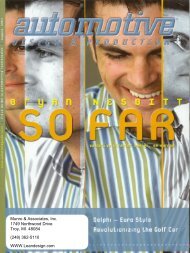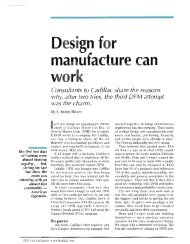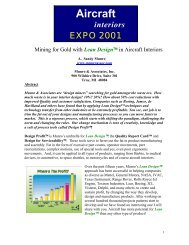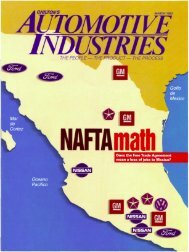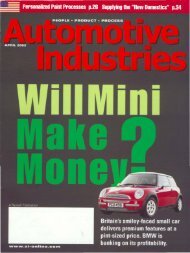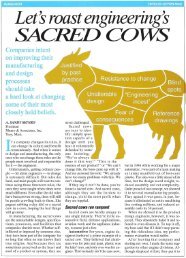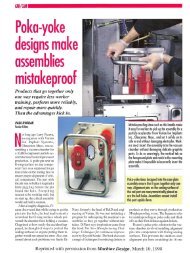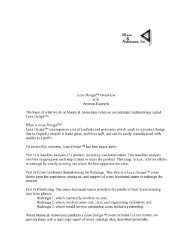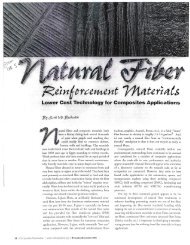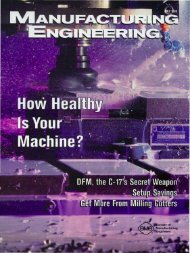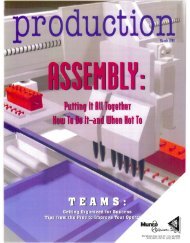Business Week - What Is The Secret - Sandy Munro
Business Week - What Is The Secret - Sandy Munro
Business Week - What Is The Secret - Sandy Munro
You also want an ePaper? Increase the reach of your titles
YUMPU automatically turns print PDFs into web optimized ePapers that Google loves.
~ ~<br />
...+-~.tlf:. a"~ ~RETAILING AFTER CAMPEAU HHESOFTWARESLOWDOWN<br />
~v..,..f::)~;'""<br />
f::)V ~~<br />
~<br />
~~ 0~oJ> •<br />
~..... q,'t'<br />
~<br />
~..<br />
....~
P555T! WANT ASECRET FOR<br />
MAKING 5UPERPRODUCT5?<br />
!t's all in 'design for assembly,' the brainchild of two Brits<br />
'Itwas the biggest secret we had at<br />
Ford," confides A. <strong>Sandy</strong> <strong>Munro</strong>, a<br />
former Ford Motor Co. engineer,<br />
"Absolutely nobody talked about it outside<br />
the company." Indeed, in one year<br />
alone it trimmed manufacturing costs by<br />
more than $1.2 billion and helped Ford<br />
edge out General Motors Corp. as Detroit's<br />
most profitable auto maker.<br />
"It" is a Dew approach to product<br />
development dubbed design for manufacturability<br />
and assembly, or<br />
DFMA. Now, GM is racing to make up<br />
for lost time. And dozens of other<br />
manufacturers, small as well as<br />
large, are discovering that DFMA can<br />
be a potent weapon in developing<br />
better products-better in that they<br />
not only cost less to produce hut<br />
also can exhibit higher quality and<br />
reliability.<br />
EASY TO BUILD. <strong>The</strong> movement harks<br />
back to the days when automated<br />
assembly was transforming the factory.<br />
Yet designers kept on fashioning<br />
products with disdain for how<br />
their handiwork would he produced.<br />
Meanwhile, the Japanese were grabbing<br />
market share with products<br />
that, to American eyes, were simple<br />
ripoffs. In reality, their simplicity betrayed<br />
elegant reengineering that<br />
rendered them easy to manufacture.<br />
As a result, Japanese companies<br />
could get products to market sooner,<br />
make improvements faster, and offer IBM joined them in 1983. Ford signed on prir.ter line of computer printers<br />
higher quality at lower prices.<br />
in 1984 and quickly became the biggest laur.ched by IBM in 1985. Before then,<br />
That's when the first glimmerings of supporter, throwing $660,000 into research<br />
that has since moved beyond just pan's Seiko Epson Corp. By applying<br />
IBM got its personal printers from Jadesign<br />
for assembly (DFAl dawned on<br />
Geoffrey Boothroyd. A PhD manufac- assembly to include process manufacturing.<br />
Ford also embraced the concept Japan, slashing assembly time from Ep-<br />
OFA analysis, IB~ turned be tables on<br />
turing engineer who was teaching at<br />
Britain's University of Salford, Booth- with the most fervor and has trained son's 30 minutes to only 3 minutes. Toroyd<br />
set out to develop a set of gu ide- roughly 10,000 people in DHIA.<br />
day, IBY is holding its own against offlines<br />
that would point designers, from After Peter Dewhurst joined Booth- shore rivals, cranking out nearly 500,000<br />
the start, toward designs that would ,-'------- - - - -''-- - - - -'-, printers a year at its automated fache<br />
easy to build. He envisioned a<br />
:Dry in Lexington, Ky.<br />
simple checklist that would stress MAKING MORE WITH LESS With BDI's "toolkit," New York<br />
i<br />
the economic implications of design<br />
Air Brake CA::.. cut the parts count<br />
Resuhs of using 'DFA' to analyze a gun-sight component<br />
decisions. This is crucial because,<br />
and cost by 3Q9'" and 50%, respectivewhile<br />
design is a minor factor in the<br />
BlfORt AfTER llElHJCTlON<br />
:y, on a new valve. Texas Instru-<br />
I total cost of a product, the design ASSlMBlYT1Mi (MINUTES) 129 20 85% ments Inc. did even better with ar;<br />
.I:i process fixes between 70% and 957" NUMBER Of PARTS<br />
47 12 75 infrared sighting mechanism that it<br />
~ of all costs. NUMBER OF ASSEMBLY SliPS 56 13 78 supplies to the Pentagon (table).<br />
8 When British industry turned a ~lost recently, NCR .Corp. stole the<br />
METAL FABRICATION (MI NUTES) 757 219 71<br />
~ deaf ear to Boothroyd's scheme, he JFA spotlight with a new electronic<br />
1045 BUSINESS WEEK/OCTOBER 2, 1989<br />
SCIENCE & TECHNOLOGY
cash register. NCR's model 2760 point-ofsale<br />
terminal snaps together even faster:<br />
than the Proprinter. In fact, assembly is<br />
so easy that NCR's William R. Sprague, a<br />
senior manufacturing engineer and DFA<br />
booster, can do it in less than two minutes-blindfolded<br />
(BW-May 8).<br />
With DFA'S soaring acceptance. BDt<br />
will soon get a full-time professional<br />
manager. <strong>The</strong> startup was relocated to<br />
Wa kefield, R.1, when Boothroyd and<br />
Dewhurst moved to the University oti<br />
Rhode <strong>Is</strong>land in 1985. Software sales ex<br />
ploded by 50% last year, to $414,000, and<br />
will more than double this year, th anks<br />
in no small measure tel GM.<br />
Until th is year, GM relied on a rival<br />
['IF A technique from Ge neral Electric 0:1.<br />
that blends some early work by Boothroyd<br />
and Dewhurst with a methodology<br />
developed in Japan by Hitachi Ltd. But<br />
smarting from the gains made by Ford<br />
pertly at its expense, GM decided to figh<br />
fIre with fire. In January, it retained<br />
Ford eng'ineer-turned-consultant ~ unro,<br />
wbo founded M1S for Productivity Inc. in<br />
Windsor, Ont., to infuse GM with the<br />
Boothroyd Dewhurst approach.<br />
.....TCHFUL eYL <strong>The</strong> Chevrolet-Pontiac<br />
GM of Canada Group was the test bed,<br />
and the first applications included parts<br />
for Cameros and Ftrebtrds expected in<br />
1~2 and later. Inside rs Ray tersely tha t<br />
GM expects major gains-but won't elaborate.<br />
<strong>The</strong>n, in late August, G ~ signed a<br />
$275,000, two-year license with BDl, expanding<br />
the Boothroyd Dewhurst beachhead<br />
to other GM units, including the<br />
Saturn operation. GM'S director of assembly<br />
systems, Barbara A. Sanders,<br />
says this is just the start of a shift away<br />
from the G[·Hitachi system.<br />
Meanwhile, Ford isn't sitting still.<br />
While DFA contributed only s lightly to<br />
Ole phe nomenal success of the Taurus,<br />
Donald L . Smith, Ford's corporate DF~A<br />
coordinator, boasts that 1993 will bring<br />
the f irst Ford model on which DFMA will<br />
have been used "from bumper to bump.<br />
cr." By the time GM gets to where Ford<br />
is now, he adds, "we're not going to be<br />
at that level anymore."<br />
<strong>What</strong>'s next? One idea is to mar-ry<br />
lFMA ....-ith artificial intelligence and competer-aided<br />
engineering to<br />
foster systems<br />
that will serve as real-time design<br />
advisers. Rather than wait passively to<br />
be fed designs for analys is, they'll keep<br />
a watchful eye on designs in progress<br />
and offer helpful hints on the best materials<br />
and processes for a given product,<br />
For now, Boothroyd insists that DFMA<br />
can spring to the aid of almost an)' U. S.<br />
company under the gun from offshore<br />
rivals. "If you scrutinize the design of<br />
moat J a pa nese products with DFMA<br />
tools," he says, "you'll see t hat they<br />
leave a lot to be desired."<br />
By Otis Port in Wakefield, R. J., u'ith<br />
Wmdy Zellner in Detroit<br />
110BUS!NESS WEEKiOCTOBEA 2. 1989



